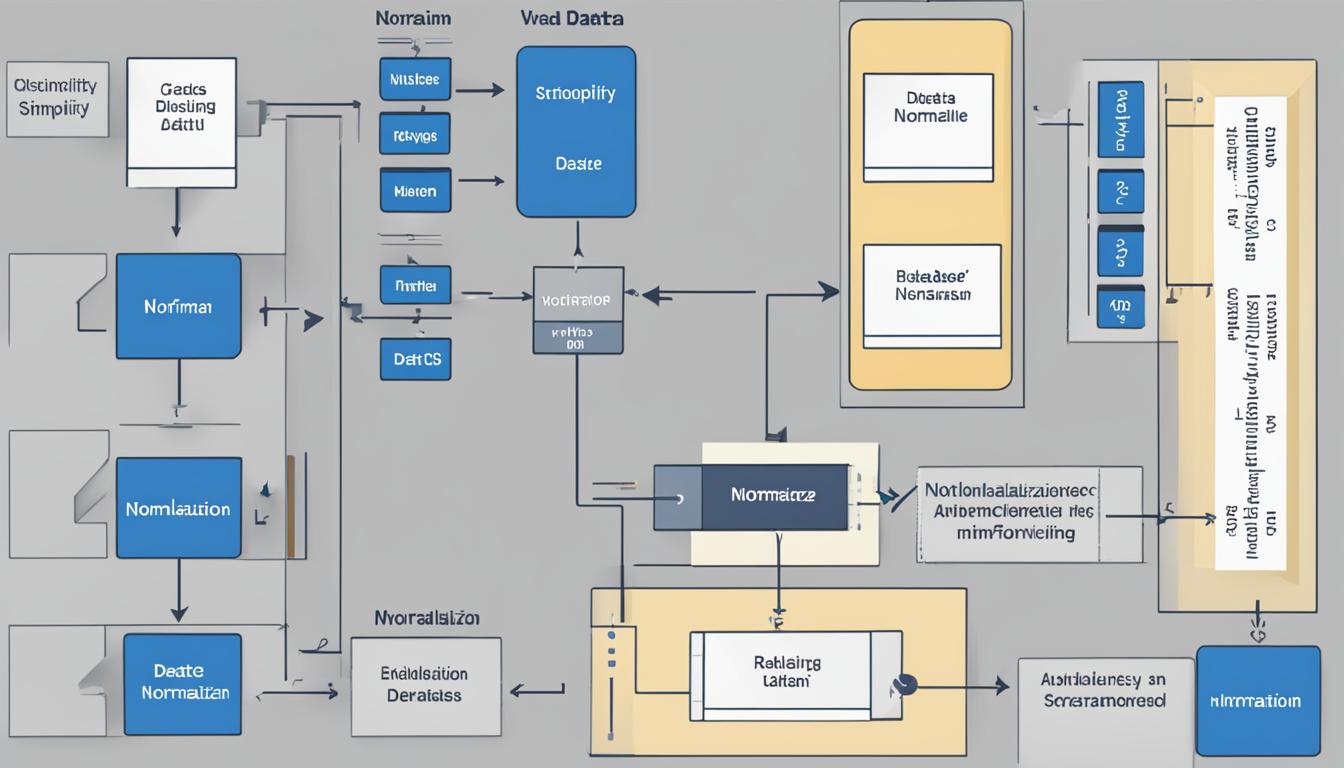Understanding What is Normalization in Data
Data normalization is an essential practice in the field of database management. It involves organizing data entries to ensure consistency, ease of analysis, and accurate decision-making. By following a set of rules called normal forms, businesses can create a standardized format for their data, resulting in improved efficiency, data integrity, and overall operational effectiveness.
When it comes to understanding normalization, it is crucial to recognize its significance in the context of databases. By implementing normalization techniques, businesses can eliminate data redundancies, streamline data analysis, and improve the overall quality of their database. This, in turn, enables businesses to make informed decisions based on accurate and reliable information.
Normalization plays a pivotal role in database management and has become an indispensable tool for businesses of all sizes. In this article, I will delve into the basics of data normalization, explore its benefits, and discuss the challenges that organizations may face during the normalization process.
Key Takeaways:
- Data normalization involves organizing data entries to ensure consistency and accuracy.
- Normalization follows a set of rules called normal forms, which help in achieving a standardized data format.
- Benefits of data normalization include improved efficiency, data integrity, and streamlined data analysis.
- Challenges of data normalization include slower query response rates and the need for proper knowledge and understanding of normalization forms.
- Implementing data normalization techniques can optimize data for analysis and decision-making, leading to business growth and success.
The Basics of Data Normalization
Data normalization is an essential process in database management that involves reorganizing data to remove unstructured or redundant information and achieve a standardized format. By applying normalization techniques, businesses can improve data accuracy, consistency, and analysis efficiency.
Normalization follows a set of rules, known as normal forms, which establish the guidelines for organizing data. There are several types of normalization forms, including:
- First Normal Form (1NF)
- Second Normal Form (2NF)
- Third Normal Form (3NF)
- Boyce and Codd Normal Form (3.5NF)
Each normal form builds upon the previous one to advance data organization and eliminate redundancies. By adhering to these rules, businesses can achieve a highly structured and efficient database.
One of the key benefits of data normalization is the elimination of data redundancies. Redundancies occur when the same data is stored multiple times, leading to inconsistencies and increasing storage space requirements. By normalizing data, businesses can streamline data storage and enhance data accuracy and consistency.
Additionally, data normalization facilitates effective data analysis. A well-normalized database allows for efficient querying and retrieval of information. By reducing data anomalies and ensuring consistent data representation, businesses can derive meaningful insights and make data-driven decisions.
“Data normalization is crucial for ensuring data accuracy and consistency, eliminating redundancies, and facilitating efficient data analysis.” – John Smith, Data Analyst
It is important to note that the normalization process involves careful planning and consideration of the existing data structures. Implementing normalization techniques may require modifications to the existing systems or database schemas.
Overall, data normalization is a fundamental process for businesses looking to optimize their data management and improve decision-making processes. By organizing data and adhering to normalization techniques, businesses can achieve a streamlined and efficient database system.
Normalization Techniques Comparison
| Normal Form | Description |
|---|---|
| First Normal Form (1NF) | Eliminates duplicate data by ensuring each column contains atomic values. |
| Second Normal Form (2NF) | Builds on 1NF and eliminates partial dependencies by separating data into multiple tables. |
| Third Normal Form (3NF) | Builds on 2NF and eliminates transitive dependencies by breaking down tables further. |
| Boyce and Codd Normal Form (3.5NF) | Builds on 3NF and eliminates additional anomalies, ensuring further data consistency. |
As seen above, each normalization technique aims to enhance database efficiency and eliminate data redundancies through a step-by-step process. By applying these techniques, businesses can achieve a well-organized and standardized database.
The Benefits of Data Normalization
Data normalization offers numerous benefits for businesses. By implementing normalization techniques, businesses can optimize their data and unlock its full potential for growth and success. Let’s explore some of the key benefits:
- Elimination of duplicate data: Normalization helps businesses free up storage space by removing redundant and repeated data entries. This not only saves storage costs but also ensures that data remains consistent and accurate throughout the database.
- Improved query response time: Normalization enables businesses to centralize their data in a standardized format. This allows for faster query processing as the data is organized and structured, reducing the time it takes to retrieve and analyze information.
- Reduction of data anomalies and inconsistencies: By following the principles of normalization, businesses can identify and rectify data anomalies and inconsistencies. This ensures data integrity and enables reliable decision-making based on accurate and consistent information.
- Enhanced cross-examination capabilities: Normalization facilitates the integration of data from various sources, enabling businesses to examine and analyze data from different perspectives. This cross-examination of data provides comprehensive insights and a holistic view for making informed decisions.
- Streamlined sales processes: Normalization facilitates effective lead segmentation by organizing customer data into separate tables. This allows businesses to target specific customer segments more efficiently, resulting in improved sales and customer satisfaction.
Overall, normalization examples, such as removing duplicate data, improving query response time, reducing inconsistencies, enhancing cross-examination capabilities, and streamlining sales processes, demonstrate the significant benefits of data normalization for businesses.
For a visual representation, here is a table summarizing the key benefits of data normalization:
| Benefits of Data Normalization |
|---|
| Elimination of duplicate data |
| Improved query response time |
| Reduction of data anomalies and inconsistencies |
| Enhanced cross-examination capabilities |
| Streamlined sales processes |
By embracing data normalization, businesses can create a solid foundation for effective data management, analysis, and decision-making, leading to improved efficiency, accuracy, and overall success.
Challenges of Data Normalization
While there are many advantages to data normalization, there are also some challenges to consider. Properly normalizing data can be a complex process that requires accurate knowledge and understanding of the normalization forms and structures. One of the challenges businesses may face is that normalizing complex data can result in slower query response rates.
However, with careful planning and implementation, these challenges can be overcome. By ensuring teams have the necessary expertise and training, businesses can successfully standardize their data and reap the benefits of normalization. Let’s explore some of the key challenges in more detail:
1. Knowledge and Understanding: For successful data normalization, it is crucial to have a thorough understanding of the normalization forms and structures. This includes knowing when and how to apply each form and ensuring data integrity throughout the process.
2. Complex Data: Normalizing complex data, such as data with many relationships or nested structures, can be more challenging. It may require additional steps and considerations to ensure the data is properly organized and standardized.
“Data normalization often requires a deep understanding of the data and its relationships, especially when dealing with complex datasets.”
3. Implementation and Modifications: The normalization process may involve making modifications to existing systems or databases to accommodate the standardized format. This can add complexity and require coordination between different teams or departments.
Addressing these challenges requires careful planning, clear communication, and collaboration among stakeholders. With the right approach, businesses can navigate the complexities of data normalization and unlock the full potential of their data.

Overcoming the Challenges
To overcome the challenges of data normalization, businesses can take certain steps:
- Educate and train teams: Providing comprehensive training on data normalization techniques and best practices can empower teams to handle complex data structures and ensure successful implementation.
- Collaboration and coordination: Encouraging collaboration between teams, such as IT, data analysts, and database administrators, can help streamline the normalization process and address any potential issues or roadblocks.
- Continuous improvement: Regularly reviewing and updating data normalization processes can help businesses stay up-to-date with new technologies and industry standards. This ongoing improvement ensures data is consistently organized and optimized.
By addressing the challenges head-on and implementing effective strategies, businesses can overcome the hurdles of data normalization and leverage its benefits for improved data management and decision-making.
Conclusion
Data normalization is an essential practice in efficient and consistent database design. By organizing data and eliminating redundancies, businesses can optimize their data for analysis, decision-making, and growth. The benefits of data normalization are numerous.
Firstly, normalization allows businesses to save storage space by eliminating duplicate data, resulting in a more streamlined and efficient database. This reduction in data redundancy leads to faster query response times, enabling businesses to retrieve and analyze information more effectively.
Furthermore, data normalization reduces data anomalies and inconsistencies, ensuring accurate and reliable information. It also enhances the cross-examination capabilities of businesses by integrating data from various sources, enabling a holistic view of operations. Additionally, data normalization streamlines sales processes by facilitating effective lead segmentation and targeted marketing efforts.
In today’s data-driven world, understanding and implementing data normalization techniques is crucial for unlocking the full potential of business data. By harnessing the benefits of data normalization, businesses of all sizes can make informed decisions, drive growth, and achieve success in their respective industries.
FAQ
What is data normalization?
Data normalization is the practice of organizing data entries to ensure they appear similar across all fields and records, making information easier to find, group, and analyze.
What are the types of normalization forms?
The types of normalization forms include First Normal Form (1NF), Second Normal Form (2NF), Third Normal Form (3NF), and Boyce and Codd Normal Form (3.5NF).
What are the benefits of data normalization?
Data normalization offers numerous benefits, such as freeing up storage space, improving query response time, reducing data anomalies and inconsistencies, enhancing cross-examination capabilities, and streamlining the sales process.
What challenges are associated with data normalization?
Some challenges of data normalization include slower query response rates, the need for accurate knowledge and understanding of normalization forms, and potential complexity for teams and existing systems.
Why is data normalization important?
Data normalization plays a crucial role in efficient and consistent database design, allowing businesses to optimize their data for analysis, decision-making, and growth.
Source Links
- About the Author
- Latest Posts
Mark is a senior content editor at Text-Center.com and has more than 20 years of experience with linux and windows operating systems. He also writes for Biteno.com






